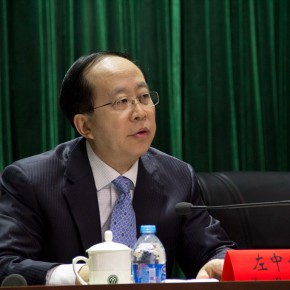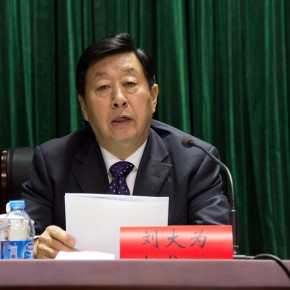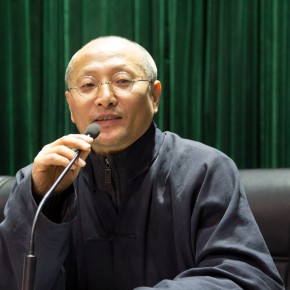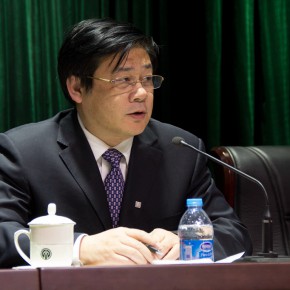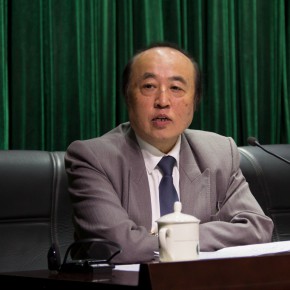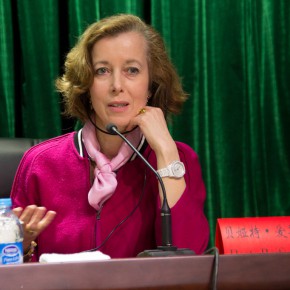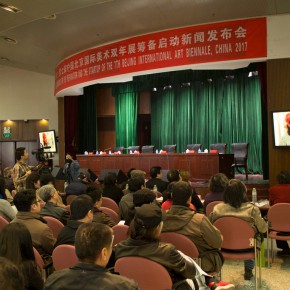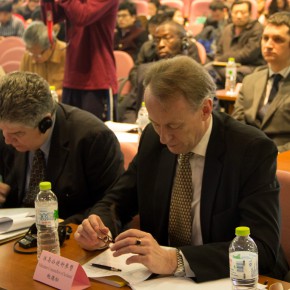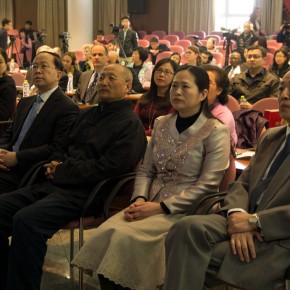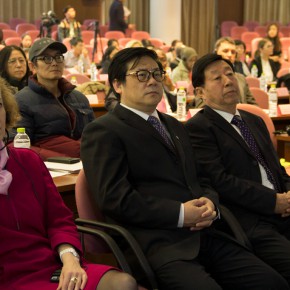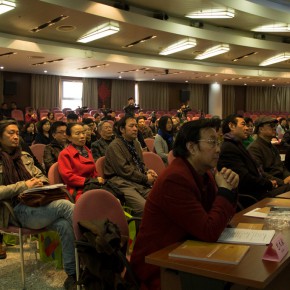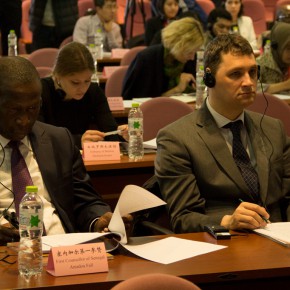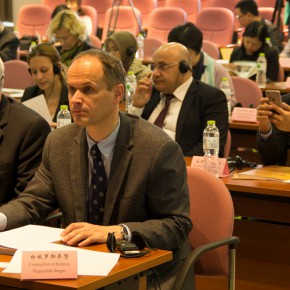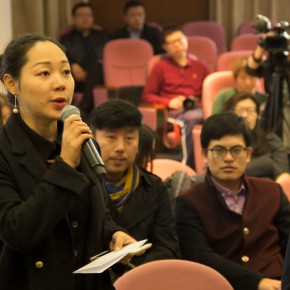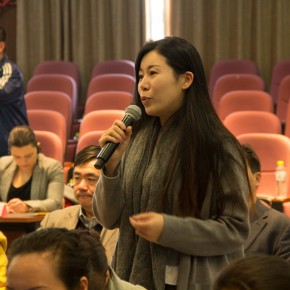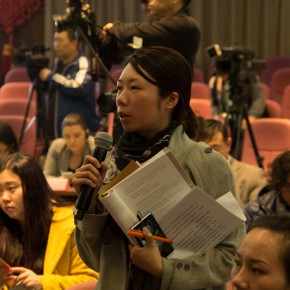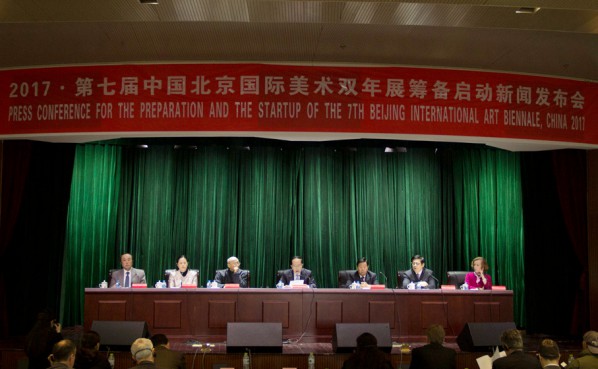
Founded fifteen years ago, the Beijing International Art Biennale has been influential in China and the world. It will attract international avant-garde information and experience on the basis of existing achievements, continuously upgrading its quality and characteristics, and continuing reforms to accumulate experience and make improvement. Now a new team of young and professional curators has been reorganized, and the Curatorial Committee has decided to hold the 7th Beijing Biennale between late September and mid-October in 2017 at the National Art Museum of China.
The theme of the 7th Beijing Biennale is “The Silk Road and World's Civilizations”
The Silk Road was an ancient traffic route connecting China to Eurasia and Africa, including a land (desert) Silk Road, a grassland Silk Road, a maritime Silk Road, and a southwest Silk Road, all of which played important roles in political, economic and cultural exchanges since the Qin and Han eras. In recent years, Chinese President Xi Jinping put forward the “Belt and Road” strategic concept (Silk Road Economic Belt and the 21st Century Maritime Silk Road), and has publicly spoken about “carrying forward the spirit of the Silk Road” on several occasions, prompting an enthusiastic response from the international community.
The Silk Road is not only an economic trade route, but also a road for cultural exchange. In promoting the economic development of the "Belt and Road," China is also stressing cultural engagement. East-West exchange, mutual learning and equal dialogue between different ethnic cultures will help achieve humanity's common goal of world peace and development; call it the new spirit of the ancient Silk Road. The ancient Silk Road not only once brought great benefits to those who lived along its path and promoted East-West cultural exchange, but has now gone beyond its immediate vicinity to encompass the shared spiritual values of mankind that can promote realization of common dreams in pursuit of world peace and development.
The name “Silk Road” was first used by the German geographer Ferdinand Paul Wilhelm Richthofen, and the Road was created together by nations in the East and the West. Works of the Silk Road by Western scholars has grown over the last century. American scholar Valerie Hansen's Silk Road: A New History offers some of the latest research. China’s “Belt and Road” Initiative motivated the spirit of the Silk Road and apply a new meaning to it. The theme of the 7th Beijing Biennale is “The Silk Road and World’s Civilizations” which both inspires artists along the Silk Road, and arouses enthusiasm and inspiration of artists beyond the Silk Road countries and extends to the whole world.
The Silk Road is a great example of humankind's cultural heritage. Based on its accumulated hundreds of participating countries in the previous sessions, the 7th Beijing Biennale with its theme related to the “Silk Road” will bring together one hundred countries on five continents to effect visual representations and interpretations of the ancient and present-day Silk Road from a modern perspective. The works of the 7th Beijing Biennale will not be limited in the ancient and present Silk Road as it will depict global civilizations from a temporal, spatial and anthropological perspective. Fine Arts, especially paintings and sculptures are the most effective way to express emotions. It is dream of China and that of the world to create a blueprint for “a community of common interests, responsibility and destiny featuring political trust, economic integration and cultural inclusion.”
To explore the exchange of human civilizations by means of visual art and to present the achievements of communication of world civilizations is conducive to form a “new mode” for dialogue between the ancient and the present and between China and foreign countries and to promote cultural recognition and identification in the global community. As for the artwork creation for the 7th Beijing Biennale, because of complex and abundant subject matter of the theme of “The Silk Road and World's Civilizations”, specific orientations and choices still have to follow artists’ personal discovery under the premise of full respect for the discipline of artistic creation. Artists are expected to draw inspiration from such topics as The Silk Road and World's Civilizations and make their creations forged together in a spiritual communion with the theme and pay respect to human civilizations while at the same time injecting new ideas and meaning to the ancient motif featuring unique perspective, abundant forms and characterized expressions.
The Origin of the Beijing Biennale
In 1895, the first International Art Biennale was held in Venice, Italy. From then on, especially since the 1980s, the art biennale has become an internationally prevailing mode of art exhibitions. In 2003, based on established practices of international art biennales, approved by the State Council of China, we set up the Beijing International Art Biennale with Chinese characteristics (Full name: Beijing International Art Biennale, China; for short: Beijing Biennale). Beijing Biennale is a regular and large-scale international art exhibition co-sponsored by the China Federation of Literary and Art Circles, the Government of Beijing Municipality and the China Artists Association.
Founded in 2003, the Beijing Biennale has been successfully held for 6 sessions in 2005, 2008, 2010, 2012 and 2015. The Beijing Biennale serves as a bridge and a bond that connects the Orient and Occident and the traditional and the modern. Held in Beijing, China’s political and cultural capital, the Beijing Biennale enjoys unique geographical advantages and cultural strength. The successful holding of the Beijing Biennale indicates that China, a country with a 5,000-year history of civilization and Beijing, the ancient capital of Chinese culture with a 800-year history serving as the capital of China, have joined the international cultural and artistic dialogues through the exhibition. It is conducive for building the diversified modern art history and presenting the multi-dimensional world’s modern artistic scenery which is both parallel and overlapped. To some extent, the Beijing Biennale adjusted the long-term imbalance between the Orient and the Occident and established an exhibition operation mode both following the international practices and respecting the circumstances of China.
Review of the Previous Beijing Biennales
A system of collective curatorial committee which is composed of famous art experts and scholars from home and abroad is adopted by the Beijing Biennale. Taking the ideal of building a harmonious world as the basis of exhibition planning ideas, the Beijing Biennale aims to promote the world harmony, social progress and happiness of humanity through exhibitions of the contemporary art. So far, the Beijing Biennale has been held for six times with an increasing number of countries and regions participating in the exhibition. The number of participating countries has increased from 45 in the first session to 96 in the sixth one in a short period of about 10 years. The accumulated number of artists and the exhibits registered separately at about 4000. The submissions for the exhibition from both home and abroad was about 10.000 and the number of visitors of the exhibition surpassed one million. Leaders from related departments and ambassadors and cultural officials from dozens of foreign countries and representatives of artists attended the opening ceremony and visited the exhibition. During every session of the Beijing Biennale, an international academic symposium was successfully held, which indicates that the philosophy, the theme, the evaluation system and the organization mode of the Beijing Biennale has won the recognition and respect of the artists around the world. Beijing Biennale has already become an important platform for extensive dialogues in art between China and the International community.
With the theme “Innovation: Contemporary and Regional”, the first Beijing Biennale advocated the spirit of cultural innovation that accommodated contemporaneity and regionalism. The theme of the second Biennale was “Humanistic Care of the Contemporary Art” which expressed the contemporary art’s focus on the real life in society and the general public. “Colors and Olympics”, the theme of the third Biennale, revealed and interpreted the Olympic spirit. “Ecology and Home”, the theme of the fourth Beijing Biennale, revealed the attention of Chinese and foreign artists to ecological problems and their position and responsibility. The theme of the fifth Beijing Biennale---“Future and Reality” combined the spiritual pursuit of the future with the humanistic care in reality with a view to building an art world in which we could go beyond reality and head to the future.“Memory and Dream”, theme of the 6th Beijing Biennale can be interpreted as: The memory is the inscription on people’s hearts, accumulation of the history, treasure house of the spirit and space to be explored by art. Every nation in the world has their unique historical and cultural memory. Dreams are beautiful ideals of people, hopes which put an end to disasters, visions for pursuing happiness and goals which call for relentless efforts.
Every Beijing Biennale drew close attention of the news media from home and abroad and they made enthusiastic coverage of the event. Take the 6th Beijing Biennale as an example: The China Central Television’s (CCTV) national news program “XinwenLianbo”, or News Broadcast and the website of the State Council Information Office reported the exhibition in a timely manner. The Reuters, one of the three leading multi-media news agency broadcast a 5-minute publicity video based on all participating artworks of the exhibition. Prensa Latina, the Latin American News Agency said: the 6th Beijing Biennale is taken by foreign artists as a pivot in China for international contemporary paintings and sculptures. The overseas edition of the People’s Daily summed up the reasons behind the attraction of the Beijing Biennale to global artists into 2 points: 1.The theme strikes a resonance with artists. 2. It pursues to win the recognition of the artistic community. Posters with the theme of the 6th Beijing Biennale appeared twice on the large screen of the Times Square in New York which is the crossroads of the world. The theme lecture “From Venice to Beijing—International Art Biennale” which was organized National Art Museum of China and opened to the public gave clear-cut orientation to Beijing Biennale: it initiates the Chinese model of International Art Biennale and becomes the center to show contemporary painting and sculpture. Worldwide Books, an international supplier of catalogues and art books, voluntarily introduced the catalogue of the Beijing Biennale to the Metropolitan Museum of Art, the J. Paul Getty Center Museum and etc. Since the opening ceremony of the 6th Beijing Biennale, average daily amount of audience is close to 10,000. The total number of audiences marked a new high in terms of the number of audience of a single exhibition at the National Art Museum of China in 2015. More than 200 artists came to Beijing to attend the opening ceremony and the symposium.
Through the two parts of theme exhibition and special exhibition with contemporary paintings and sculptures as its main exhibits and part of some new media artworks like installation, videos and mixed media, Beijing Biennale displays the comprehensive latest development of global paintings and sculptures. Meanwhile, it highlights the advantage of international art communication without borders, fully embodies the infinite possibility of worldwide artists to create works according to the theme, and shows that the Beijing Biennale is different from other biennales, and the feature is also well received and supported by artists from different countries in the world.
Prospects of the 7th Beijing International Art Biennale
To carry forward the eternal spirit of the Silk Road,
To paint the common dream of peaceful development,
To pursue the spiritual value of human being,
To show the exchange and integration of world’s civilizations.
Speech at the Press Conference for Preparations and Launch of the Seventh Beijing International Art Biennale
Zuo Zhongyi
(March 18, 2016, Beijing)
Distinguished guests, friends from the media, ladies and gentlemen:
Hello everyone! A few days ago, China's NPC and CPPCC sessions this year ended, and the Thirteenth Five-Year Plan adopted by the sessions depicts a grand blueprint for the next five years in China. The plan proposes to improve our level of opening up, increase the intensity of Chinese and foreign cultural exchanges, and expand the space of cultural exchanges and cooperation. This once again shows China’s faith in unswervingly following the road of peaceful development. Against this background, we started preparations for the Seventh Beijing International Art Biennale. This is of special significance and our extremely favorable condition.
As a people's organization, the China Federation of Literary and Art Circles is committed to long-term international exchange activities, and we actively organize our members of the literary and art circles to undertake lively international cultural exchange activities in various forms. We try to introduce Chinese literature and art to the world, building a platform for the Chinese people to understand the world of art, and thus promoting exchanges and cooperation between Chinese and foreign artists.
There have been six successful Beijing International Art Biennales since 2003, covering the themes of "Innovation: Contemporary and Regional," "Humanistic Concern of Contemporary Art," "Colors and Olympics," "Ecology and Home, ""Future and Reality," "Memory and Dream" and accumulating over a hundred participating countries, nearly 4,000 participating artists, nearly four thousand works on display, as well as more than a million visitors. East and West, tradition and modernity, they blend and exchange for mutual learning. The Beijing Biennale has gained wide recognition and positive response from more and more Chinese and foreign artists as unique beautiful scenery in the world of visual arts, witnessing the close exchanges and enhanced friendship between Chinese and foreign artists.
The upcoming Seventh Beijing International Art Biennale is still sponsored by the China Federation of Literary and Art Circles, the Beijing Municipal Government and the China Artists Association. The theme of the exhibition is "The Silk Road and World’s Civilizations." We are familiar with the Silk Road. The Silk Road for thousands of years witnessed the legend of the peoples of various countries standing hand in hand overcoming difficulties, leaving an important chapter in the history of cultural exchanges and mutual learning. It was not only an important trade road, but also a road of cultural exchanges between different countries and nations, which not only benefited the peoples in countries along it, but also contributed to the progress of the world civilizations and human society. On the long stretches of the Silk Road, there are endless sceneries and tales. In a certain sense, the Silk Road itself can be seen as a comprehensive work of "visual art" created collectively by peoples of various countries against a vast background of time and space. In the eyes of artists, perhaps the Silk Road can be seen as static or dynamic scroll paintings and sculptures everywhere. Today, artists of various countries will once again gather on the Silk Road, and I believe that not only will they bring visual expression across geographical regions through the ancient and modern eras, but will show us the artistic interpretation of human contacts and exchanges in a larger scope, wider field, and deeper level, with a new chapter of integration and development of the world civilizations.
Chinese President Xi Jinping pointed out, "Civilizations have become richer and more colorful with exchanges and mutual learning. Such exchanges and mutual learning form an important drive for human progress and global peace and development. “Literature and art are an effective way of mutual understanding and communication between different countries and peoples. As a universal language, the influence of fine arts goes beyond time and space, spanning across borders. Whether it is a painting or a sculpture, it can provide a unique perspective to show different civilizations. The Seventh Beijing Biennale will continue adhering to artistic ideas of building a harmonious world and respecting cultural diversities in order to carry forward academic democracy, democracy in art, and create a positive, healthy, relaxed and harmonious atmosphere for the exhibition. We promote full discussion of different views and schools on this platform, full development of artistic genres, subject matters, forms and means, and promote active innovation of artists in concept, content, style and genre of their works. I believe that the millennium Silk Road full of artistic inspiration will provide a vast space for artists to showcase their talents and learn skills from each other. We also look forward to the emergence of more and more fantastic paintings and sculptures at the exhibition, each having its own merit, exploring cultural fusion from the perspective of visual arts, to show results of blending civilizations.
Today, China is making unremitting efforts to achieve the Chinese dream of the great rejuvenation of the nation. The Chinese dream is not just the dream of the Chinese people to pursue happiness, but also connects with the beautiful dream of all peoples. It advocates a sense of community of human destiny, an open and inclusive spirit of exchange and cooperation, and diversification of world civilization. China's "Belt and Road" initiative that various countries work together to promote the construction of the "Silk Road Economic Belt" and the 21st Century "Marine Silk Road" has given new meaning to the Silk Road. Let’s carry on peace and cooperation, openness and tolerance, mutual learning, mutual benefit and win-win spirit of the Silk Road, to promote the prosperity of the arts and the progress of human civilization: these are the common aspiration of peace-loving people and the artists, and also the aim of the Seventh Beijing Biennial. We will take the opportunity of carrying forward the "spirit of the Silk Road," connecting ancient and modern times, things Chinese and foreign, to stick to the multi-level and wide-ranging pattern of international cultural exchanges, fully absorb the outstanding achievements of human civilization, continue to strengthen the international cultural exchange brand of the Beijing Biennale and incessantly enhance its international appeal and influence. It should be noted that exchanges and mutual learning between different civilizations are an important trend of contemporary cultural development in the world. With the Silk Road as a leading thread, we will explore the historical and cultural heritage of the Silk Road, to show the unique charm of the Silk Road, set up the new bridge of the world cultural exchanges and dialogues, "weave" the territory of paintings and sculptures of contemporary world civilization, and strive to create a beautiful blueprint of "culturally inclusive community of interests, community of responsibility and community of destiny based on political trust and economic integration" as artists’ noble mission. We expect Chinese artists to tell Chinese stories well to the outside world, the story of the Silk Road with their colorful brush, disseminating Chinese aesthetic spirit, showcasing the tremendous progress in Chinese society today and a new look of the people. They will show adequate character and historical accountability of Chinese art workers with outstanding works in Chinese style. We also expect foreign artists to find inspiration from the Silk Road, demonstrating on this platform of the Beijing Biennale the artists’ perception and understanding of civilizations, sharing spiritual experience and artistic attainments of different ethnic groups, in an effort to further consolidate the cooperation and friendship of international art world and make new contributions to the prosperity and development of art in the world, the common progress of human civilization and the peace and development of the world.
Thank you all.
Speech at the press conference for starting the preparations of The Seventh Beijing International Art Biennale
By Liu Dawei
(On the morning of March 18, 2016; at the Lecture Hall of the China Federation of Literary and Art Circles, 4th floor of the CFLAC Building)
Dear Vice Chairman Zuo, distinguished diplomats, Chinese and foreign media friends,
Ladies and gentlemen:
Good morning! Since its inception in 2003 in line of international practice, the Beijing Biennale, co-sponsored by the China Federation of Literary and Art Circles, the Beijing Municipal Government and the China Artists Association, and organized by the China Artists Association, has become a biennale with Chinese characteristics after 14 years of development. In the previous six successful exhibitions, participating countries increased from 45 in the first to 96 in the last one, with a total of more than one hundred countries and nearly 4,000 artists participating. Nearly four thousand works were on display, based on tens of thousands of contributions from China and other countries, attracting a total of over one million visitors. Chinese leaders concerned and diplomats, cultural officials and artists from dozens of countries attended the opening ceremony or visited the exhibition, including the Xinhua News Agency, CCTV, People's Daily, China Daily ,Guangming Daily and Reuters, BBC, Philadelphia Daily News, ABC News, Radiotelevisione Italia, Prensa Latina, the Spanish news agency EFE, El Comercio from Peru, Venezuela Cosmic News, Korean Joongang Daily, etc. Hundreds of Chinese and foreign newspapers, magazines, television, radio, and online media covered the exhibitions from different angles, with comprehensive in-depth coverage in various forms. From various aspects this shows the gradually expanding international appeal and influence of Beijing Biennale. Beijing Biennale, through the accumulation of the six exhibitions, has become the most important platform for extensive dialogues between Chinese art and the world and our exhibition purposes, themes of the exhibitions, evaluation system and organization method have been widely accepted, respected and orientated by the artists around the world. The Beijing Biennale has been unique among world-class international biennales for its aim at contemporary extension in painting and sculpture, with initial success in promoting the worldwide return and revival of easel painting.
Next year will be the 15th anniversary of the founding of the Beijing Biennale, and in 2017 we will host the Seventh Beijing Biennale. On the basis of the success of the sixth Beijing Biennale in 2015, the first curators’ meeting was held in January 2016 in time. On the setting of the theme of the 7th Beijing Biennale, the curators discussed deeply and put forward various ideas from the perspectives of art theory and creation practice, such as “the spirit of the Silk Road, the world’s civilizations, ecology and homeland, peace and co-prosperity, local culture and art’s ecology”, and finally the theme was decided and the exhibition regulation was improved. We decided to schedule the seventh Beijing Biennale at the National Art Museum of China in late September to mid-October 2017. After the meeting, the Organizing Committee immediately starts to edit and produce promotion brochures and videos of the 7th Beijing Biennale. From the promotion brochure in your hand, you can find we organizer have done a lot of deep, academic, complete and intuitive job. We believe that artists from different countries could get inspirations on the theme creation through these clear and detailed interpretations both in pictures and words.
The theme of the Seventh Beijing Biennale is "The Silk Road and World’s Civilizations."
The Silk Road is a bond linking the world’s civilizations, the main road between East and West cultures, witnessing the mutual learning of world's civilizations and it has become a symbol of East-West cultural exchanges. Now many ancient Silk Road cities have been reduced to rubble, but the Silk Road spirit is timeless. The theme of 2017 Seventh Beijing Biennale "The Silk Road and World’s Civilizations" is aimed to promote the Silk Road spirit, the mutual learning of world civilizations and the exchange and integration of contemporary East-West cultures, and man’s common dream of world peaceful development. Artists invited are not limited to countries along the Silk Road, but we have included artists around the world, because the spirit of the Silk Road has shared spiritual values of mankind, and it has attracted the attention of contemporary artists around the world. Our subject matter is not limited to depicting the ancient Silk Road sites, not just nostalgia, but rather we focus on the performance of the Silk Road spirit – showing to the world the spirit of civilization mutual learning, in particular the spirit of contemporary East-West cultural integration.
Themes about the "Silk Road" are complex and broad, and materials of world’s civilizations are illuminating as heavenly stars, so for the specific exploration, discovery, conversion and screening, we will fully respect the choices of individual artists in the context of compliance with the law of artistic creation. Artists are expected to work with the "Silk Road" and "world’s civilization" in the spiritual connotation, and inject ideas and cultural connotation of our new era in the "old" "Silk Road" motif, and pay tribute to human civilization from a unique perspective, with rich forms in personal languages.
In the ancient times, the Renaissance in Europe benefited from the impact of the East-West cultural exchanges on the Silk Road; today, it is Chinese dream, a dream of the world, and a great call from the millennium Silk Road to bring together the world’s civilizations in the 21st century on the new Silk Road! It will also be the most anticipated exciting show at the Seventh Beijing Biennale!
Courtesy of the China Artists Association, edited by Sue/CAFA ART INFO.


